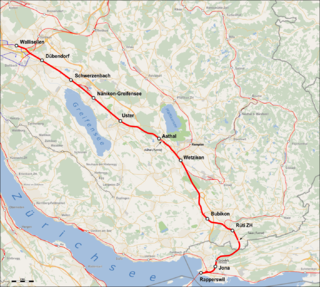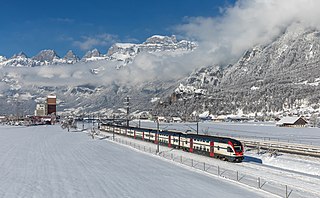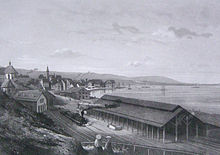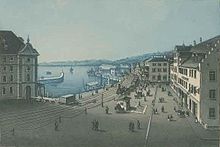
The Bodensee–Toggenburg railway is a mainly single-track standard-gauge line connecting Romanshorn on Lake Constance and the Toggenburg region in Eastern Switzerland. It was built by the Bodensee-Toggenburg-Bahn (BT), a former railway company, which existed from 1910 until its merger with the "old" Südostbahn (SOB) to form the "new" Südostbahn (SOB) on 1 January 2001. Today, the line together with the Wattwil–Ebnat-Kappel section forms the eastern network of the Südostbahn.

The Wallisellen–Uster–Rapperswil railway line is a railway line in the canton of Zürich in Switzerland. It is also known as the Glatthalbahn, Glatttalbahn or Glattalbahn (Gl-TB), although the latter name is now more commonly used to refer to the Stadtbahn Glattal, a nearby light rail system.

The Swiss Northeastern Railway was an early railway company in Switzerland. It also operated shipping on Lake Constance (Bodensee) and Lake Zürich. Until the merger of the Western Swiss Railways into the Jura–Simplon Railway (JS) in 1890/91, it was the largest Swiss railway company.

The Lake Line, as it is referred to by the SBB in English, is the Swiss railway line running from Rorschach via Romanshorn, Konstanz (Germany), Kreuzlingen, Steckborn, Stein am Rhein and Diessenhofen to Schaffhausen. The scenic route follows the southern border of Lake Constance and the High Rhine. It forms the Swiss section of the ring railway around Lake Constance.

The Südostbahn – commonly abbreviated to SOB – is a Swiss railway company, and a 1,435 mmstandard gauge network in Central and Eastern Switzerland. It resulted from the merger of the original SOB with the Bodensee–Toggenburg railway (BT) at the end of 2001.
The construction and operation of Swiss railways during the 19th century was carried out by private railways. The first internal line was a 16 km line opened from Zürich to Baden in 1847. By 1860 railways connected western and northeastern Switzerland. The first Alpine railway to be opened was under the Gotthard Pass in 1882. A second alpine line was opened under the Simplon Pass in 1906.

Rüti ZH is a railway station in the municipality of Rüti in the Swiss canton of Zurich. The station is located on the Wallisellen to Rapperswil line just south-west of its junction with the Tösstalbahn from Winterthur via Wald. It is served by passenger trains of the Zurich S-Bahn.

St. Gallen railway station serves the town St. Gallen, the capital of the canton of St. Gallen in Switzerland. It is located at the junction of the standard gauge St. Gallen–Winterthur, Rorschach–St. Gallen, and Romanshorn–Toggenburg lines of Swiss Federal Railways and the 1,000 mm gauge Appenzell–St. Gallen–Trogen line of Appenzell Railways.

Rorschach railway station is a railway station in Rorschach, in the Swiss canton of St. Gallen. It sits at the junction of four railway lines: Chur–Rorschach, Rorschach–St. Gallen, Rorschach–Heiden, and the Lake Line. It is the primary station for Rorschach and is served by local and long-distance trains.

Sargans railway station is a railway station in Sargans, in the Swiss canton of St. Gallen. It is an intermediate stop on the Chur–Rorschach line and eastern terminus of the Ziegelbrücke–Sargans line. It is served by local, regional, and long-distance trains.

The St. Gallen–Winterthur railway line is a standard gauge railway line between St. Gallen and Winterthur, connecting the Swiss cantons of St. Gallen, Thurgau and Zürich. The 57.1 km (35.5 mi) long line was opened between 1855 and 1856 in four stages by the former St. Gallen-Appenzell Railway and belongs to the Swiss Federal Railways (SBB). It is part of the West-East main line in Switzerland.

The Chur–Rorschach railway line, also called the Rhine Valley line, is a standard gauge railway line in Switzerland. It belongs to the Swiss Federal Railways (SBB) and is located in the cantons of St. Gallen and the Grisons.

The Ziegelbrücke–Sargans railway line is a railway line in the Swiss cantons of St. Gallen and Glarus owned by Swiss Federal Railways (SBB) and operated by services of SBB, SOB, ÖBB and DB. It connects Ziegelbrücke with Sargans via Lake Walen and the Seez Valley.

The Winterthur–Romanshorn railway, also known in German as the Thurtallinie, is a Swiss railway line and was built as part of the railway between Zürich and Lake Constance (Bodensee). It connects Winterthur with Romanshorn, where it formerly connected to train ferries over Lake Constance. It is the fourth oldest internal railway in Switzerland. Its construction was to be funded by the Zürich-Lake Constance Railway (Zürich-Bodenseebahn), but during the construction the company was merged with the Swiss Northern Railway to form the Swiss Northeastern Railway. The Winterthur–Romanshorn railway was opened on 16 May 1855 and the line from Winterthur to Oerlikon was opened on 27 December 1855. Zürich was reached on 26 June 1856 and the two existing NOB lines were connected.

The Rapperswil–Ziegelbrücke railway line is a single-track standard-gauge railway line in Switzerland. It was built as part of the route from Rüti to Glarus, which was opened by the United Swiss Railways on 15 February 1859.

The Rapperswil–Pfäffikon railway is a 3.51 km (2.18 mi) long, mostly single-tracked standard-gauge railway line connecting Pfäffikon in the Swiss canton of Schwyz with Rapperswil in the canton of St. Gallen, crossing Lake Zürich using the Hurden peninsula and Seedamm causeway.

The original Schweizerische Südostbahn was a railway company in Central Switzerland with its headquarters in Wädenswil. It was created in 1890 by the merger of the Wädenswil-Einsiedeln-Bahn and the Zürichsee–Gotthardbahn and operated the standard gauge adhesion railways on the Rapperswil–Arth-Goldau and the Wädenswil–Einsiedeln routes. It merged in 2001 with the Bodensee–Toggenburg railway (Bodensee-Toggenburg-Bahn) to form the "new" Südostbahn.

The Wil–Ebnat-Kappel railway is a single-track standard-gauge line that runs through the Toggenburg region of Switzerland. It was built by the Toggenburgerbahn. Its 25 kilometre-long, standard gauge line from Wil via Wattwil to Ebnat-Kappel was opened on 24 June 1870. The TB was nationalised as of 1 July 1902 and became part of the Swiss Federal Railways (SBB).

The S4 is a railway service of the St. Gallen S-Bahn that provides hourly service between Sargans and Rapperswil via St. Gallen, connecting stations in the cantons of St. Gallen and Appenzell Ausserrhoden. The section near Lake Constance is also part of the Bodensee S-Bahn. Südostbahn (SOB), a private company primarily owned by the federal government and the canton of St. Gallen, operates the service.

St. Margrethen railway station is a railway station in St. Margrethen, in the Swiss canton of St. Gallen. It is an intermediate stop on the Chur–Rorschach line and the western terminus of the St. Margrethen–Lauterach line to Austria. It is located at the Swiss–Austrian border.






























